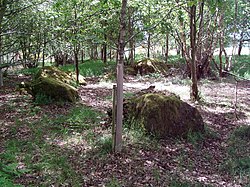Cairnbeddie
| Cairnbeddie | |
| Perthshire | |
|---|---|
 Blackfaulds Stone Circle near Cairnbeddie | |
| Location | |
| Grid reference: | NO149310 |
| Location: | 56°27’51"N, 3°22’53"W |
| Data | |
| Postcode: | PH2 |
| Local Government | |
| Council: | Perth and Kinross |
Cairnbeddie is a tiny hamlet in Strathmore, in Perthshire, sitting amongst the lanes north of St Martins.
The lands around Cairnbeddie are known for ancient remains, belying the smallness of the place today.
The name of Cairnbeddie is recorded in various forms, and is believed locally to mean "Castle of Macbeth", as this was the place where that unfortunate king had his stronghold, of which earthworks remain. Frances Groome's Ordnance Gazetteer of Scotland (1882-4) describes the hamlet:
Cairnbeddie, a hamlet in St Martin's parish, Perthshire, 6½ miles NNE of Perth. A circular mound is here, about 230 feet in diameter, surrounded by a moat 30 feet wide; bore originally the name of Caerbed or Caerbeth, signifying 'the Castle of Macbeth,' and corrupted into Cairnbeddie; is traditionally said to have been the site of a residence of Macbeth, prior to his removing to Dunsinnan; and, opened in 1822, was found to inhume many sword-handles and small horse-shoes.[1]
The site of the castle is also known as the "Giant's Knowe", and so marked on estate maps. It is today no more than a small mound in a field a little to the south of Cairnbeddie. Archaeologist have accepted the tradition that this was indeed Macbeth's castle, and discerned the moat which once surrounded it.
Close by is "the Witches' Stone" where, according to more recent tradition, Macbeth met the three witches.
Nearby too is a low stone circle, known as Blackfaulds Stone Circle.
Outside links
References
- ↑ Ordnance Gazetteer of Scotland 1882-4, Frances Groome